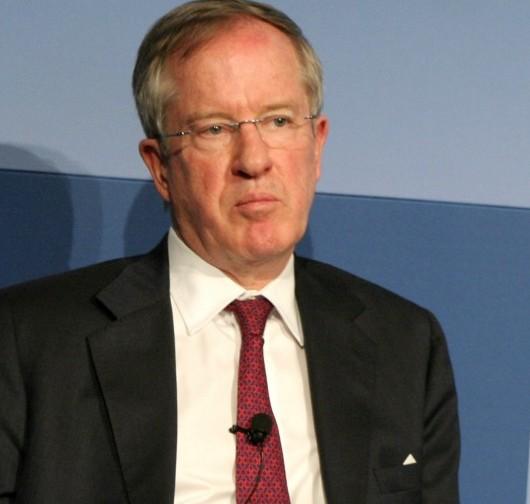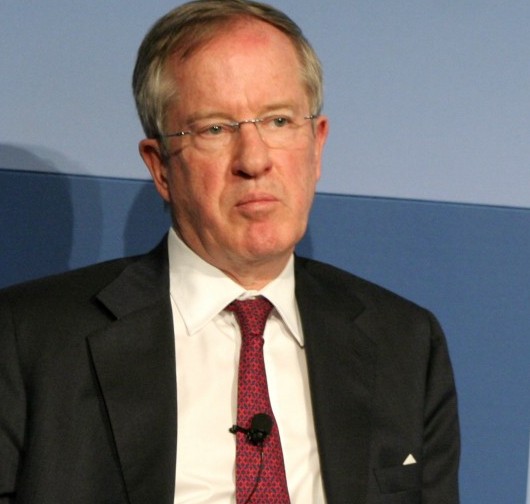Chinese economy expert Nicholas Lardy says China’s imbalances and distortions must be corrected
WASHINGTON—China managed to get through the global financial crisis of 2008–2009 with 9.2 percent growth through a fiscal and monetary stimulus program, according to Nicholas Lardy, the highly respected expert on China’s economy.
But Lardy writes in his latest book, Sustaining China’s Economic Growth After the Global Financial Crisis, that the stimulus did not address the deep structural problems and imbalances in China’s economy.
Lardy makes a strong case backed by hard numbers that China will have to fundamentally overhaul its economy if it is to move forward on a sustainable path of economic growth.
Speaking at the nonpartisan Peterson Institute for International Economics on Feb. 1 to a large audience composed of many China financial experts, Lardy said he could not imagine that the way the economy is structured—for example, housing comprising 15 percent of GDP—could continue.
For China to have high economic growth, it would have to “change the composition of demand in favor of consumption, away from investments and exports,” Lardy said in concluding his talk. Changing the structure of the economy requires addressing distortions in the savings rate, real estate market, a repressed financial system, and the currency exchange rate.
Household Savings
The Chinese economy became increasingly imbalanced beginning in 2002 or 2003, according to Lardy. He said the financial system has become significantly “repressed” in the last seven or eight years.
Before 2004, the real return on deposits for savers was 3 percent on an average. Since 2004, Lardy computes the average interest return to be in “negative territory.”
“Since the central bank has complete control of the nominal interest rate, it can generate any real return on deposits that it wishes,” Lardy said. Why then did the central bank change policy in 2004, asked Lardy? One reason is that bank profitability has been quite high. The low benchmark rate the central bank set on deposits gives the commercial banks a very cheap source of funding.
Whatever the motive, the rise in household savings as a share of disposable income after 2003 “coincides with increased financial repression that dramatically reduced the real return to savings,” he said.
A consequence of the reduction in real interest rate led to an increase in savings from disposable income. Lardy displayed a chart from 1997–2008 that shows household savings averaged 29 percent of disposable income before 2003, when the one-year deposit rate averaged 3.0 percent. After 2003, when the rates turned negative, household savings rose to an average of 36 percent of disposable income.
The increase in household savings accounted for about one quarter of the long-term decline in household consumption as a share of GDP, Lardy writes.
The behavior of Chinese savers is not what might be expected. Logically, one might expect the Chinese to save less when the interest rate (after taking out inflation) is negative.
Lardy said at the Peterson Institute that Chinese are “precautionary savers” and China is “self-insuring.” He hypothesizes that the primary reason that most people in China save is to obtain a target level of financial assets. In order to achieve their target level, households would have to save more and consume less from their income.
He says this “make sense in a society where medical insurance coverage is limited, hospital access usually depends on paying cash in advance, and relatively high down payments are required to qualify for a mortgage on a residential property.”
Lardy recommended the Chinese state build a stronger social safety net to facilitate the reduction in the household saving rate.
Outsized Real Estate Investments
Another probable outcome of the negative one-year returns on bank deposits after 2003 is the huge rise in investment in residential property—“the biggest driver of economic growth in China over the last four or five years,” Lardy said. The average house appreciation on newly constructed residential property was 4.6 percent in 2004–2010, which is a lot better than the negative return of 0.7 percent on bank deposits.
Lardy compared peak residential investment in China with other developed countries at their peak in order to show how extreme China has become. His chart shows China’s residential property investments in 2011 at roughly 9.1 percent of GDP, while the peaks in the United States (2005, 6 percent), India (2008, 5.2 percent), and Taiwan (1980, 4.3 percent) were nowhere close.
He doesn’t believe China’s residential property investment rate is sustainable, and expects a marked slowdown. “Given China’s real estate bubbles and China’s policies to suppress it,” one is confronted with the question of how China’s growth will be impacted, wrote in an email Tianlun Jian, Ph.D., a China economist, contributor The Epoch Times, and a former employee of The People’s Bank of China.
The prospects for increased personal consumption are not good, as investments dominate growth, according to Lardy. Output growth consists of three components of GDP: consumption, investment, and net exports. “Expanding investments has been a major and increasingly important driver of growth in China,” Lardy writes.
He displayed a chart showing an average investment share of GDP at 37.1 percent from 1997–2003, which was to be expected in an industrializing economy. After 2003, however, the average is 44.1 percent, which is unusually high by East Asian standards.
Meanwhile, household consumption has been falling off sharply. Average household consumption was at 46 percent in the 1990s, a decline from slightly more than half of GDP in the 1980s. Then, beginning in 2003, household consumption fell greatly, to only 35 percent of GDP in 2008 and 2009. Preliminary data show 34 percent for 2010.
The 34–35 percent rate of private consumption for 2008–2010 “is by far and away the lowest share of any major economy in the world,” Lardy writes. One can appreciate how low this rate of consumption is by recalling the United States’ lowest point of household consumption in modern times. It was 50 percent during World War II (1943–1944) when the U.S. economy was converted to wartime production, consumer goods were limited, gasoline and food were rationed, and Americans were purchasing war bonds.
Repressed Financial System
The negative real interest rates on household savings and the consequences of suppressing household income exemplify a “repressed” financial system beginning in 2003. Additionally, other policies are repressing, such as the minuscule percent of individuals allowed to purchase government bonds.
The phenomenally high levels of the reserve ratio required of commercial banks with deposits in the central bank are also repressing. The deposits required have been increasing very rapidly as the reserve ratio reached an all-time high in 2011 of 21.5 percent.
“The ’repressed' financial system means that households and corporations do not have many other options for investing their money besides the state banking system, which pays paltry interest. In a sense, the state banking system cheaply takes savings from households and companies and channels them to state-approved projects at low interest rates,” wrote in an email Dr. Christopher A. McNally, a political economist at Chaminade University, East-West Center, and the editor of “China’s Emergent Political Economy: Capitalism in the Dragon’s Lair” (2008).
“Financial repression has been a by-product of the government exchange rate policies,” which is keeping the exchange rate of the renminbi undervalued, Lardy said. The real effective exchange rate was appreciating an average of 4.4 percent in the period 1995–2002, but then slowed dramatically in the period 2003–2010 to an average of 0.5 percent. Currently, the domestic money supply increases annually at a whopping 9 percent.
In the face of these large surpluses, the central bank has intervened in the foreign exchange market, leading to a massive buildup of official foreign exchange reserves of US$3.2 trillion at midyear 2011. It’s well to remember that at the end of 2003, the reserves were only US$120 billion.
To keep inflation in check, the central bank tightens “the money not through raising interest rates, but by raising required reserve ratio to reduce the money in circulation,” Jian said.
Rebalancing Stalled
Not mentioned in this discussion on distortions in the China economy are the subsidies in manufacturing, which work to the detriment of the service sector. Emphasis on exports is well-known and like the other distortions—financial repression and undervalued exchange rate—it works against China’s economic rebalancing necessary for the current global economy.
Rebalancing trade has implications for financing the U.S. deficits. From a global perspective, China would no longer contribute to global economic imbalances that led to the global financial crisis and great recession, Lardy says.
Lardy frequently quotes Premier Wen Jiabao that significant reform is required to sustain economic growth. “China’s economic growth is unsteady, imbalanced, uncoordinated, and unsustainable,” said Wen in March 2007.
Wen has since repeatedly called for reform and rebalancing and vowed to “undertake market-based reform of interest rates,” writes Lardy in his book. Lardy notes that the Chinese communist leadership’s support for reforms can be found in the 12th Five-Year Plan and other documents.
But there is nothing new in the call for reforms, said Lardy. The needed reforms are not taking hold even in tepid steps.






